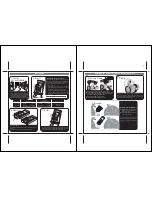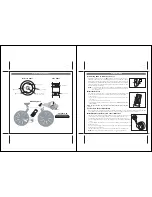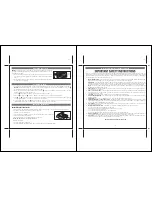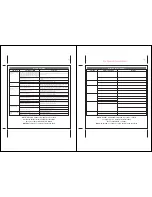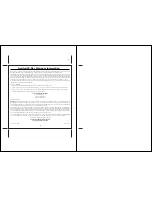
5
Batteries Installation
Listening to iPod
Charging your iPod
Install/Replace Batteries
The iH85 uses 4 “AA” batteries for portable playing. The iH85 will not charge your iPod while operating on batteries.
If sound becomes weak or distorted, replace the batteries.
• Unscrew outer case and remove
• Open the battery compartment cover located inside unit above the AC adaptor jack.
• Insert 4 “AA” batteries as indicated
• We recommend the use of alkaline batteries for longer life
NOTE: AC adaptor does not charge batteries
Batteries information:
• Do not mix old and new batteries.
• Do not mix alkaline, standard (carbon -zinc) or rechargeable (nickel-cadmium) batteries.
P7
NOTE:
Please make sure you are using the correct insert if required for your iPod
(see Page 1 for details) and that it is properly docked into the iH85. Failure to do so
may damage your iPod.
1. While your iPod is docked in the unit and the unit is connected to AC power,
it recharges (until fully charged). iPod will not be change when using battery
power.
2. When the iH85 power is OFF and iPod is charging, the LED indicator will flash
to show the iPod is charging.
1. If you dock an already-playing iPod, the iH85 will automatically turn on and you will hear music playing from your iPod.
NOTE:
If the loudness of the music is too low on the iPod itself, iH85 may not detect iPod is in play mode. Press the
iPod Play/Pause Button on the remote control twice to play it.
2. When the iPod is docked and in standby mode, press the
Power On/Off Button on main unit to play it. The LED
indicator will stay on to show it is power on.
3. Press the
iPod Play/Pause Button to pause play; press again to resume it.
4. Press the
and
Volume – Button on the remote control to adjust the system volume.
5. Press
>> or
<< Button on remote control to go to the next or previous track. Press and hold while track is playing
for high speed forward or reverse music search of the current track.
6. To turn off the iH85, press the
Power on/off Button. If the unit is connected to AC outlet, your iPod will continue
charging while in the dock. You cannot power off the unit by using remote control only.
A Consumer Guide to Product Safety
6
P8
When used in the directed manner, this unit has been designed and manufactured to assure your personal safety. However,
improper use can result in potential electrical shock or fire hazards. Please read all safety and operating instructions carefully
before installation and use. Keep these instructions handy for future reference. Take special note, and adhere to all warnings
on the unit and in the instruction and service manual.
1.
Water and Moisture
- The unit should not be used near water. For example, near a bathtub, washbowl, kitchen sink,
laundry tub, in a wet basement, or near a swimming pool, etc., when using the AC adaptor.
2.
Ventilation
- The unit should be situated so that its location or position does not interfere with its proper ventilation. For
example, it should not be situated on a bed, sofa, rug, or similar surface that may block the ventilation openings; or placed
in a built-in installation, such as bookcase or cabinet that may impede the flow of air through the ventilation openings.
3.
Heat
- The unit should be situated away from heat source such as radiators, heat register, stoves, or other appliances
(including amplifiers) that produce heat.
4.
Power Sources
- The unit should be connected to a power supply only of the type described in the operating instructions
or as marked on the appliance.
5.
Power Cord Protection
– Power supply cord should be routed so that they are not likely to be walked on or pinched
by items placed upon or against them. It is always best to have a clear area from where the cord exits the unit to where
it is plugged into an AC outlet.
6.
Cleaning
- The unit should be cleaned only as recommended by the manufacturer.
7.
Object and Liquid Entry
- Care should be taken so that objects do not fall and liquids are not spilled into the enclosure
through openings.
8.
Attachments
– Do not use attachments not recommended by the product manufacturer.
9.
Lightning and Power Surge Protection
– Unplug the unit from the wall outlet and disconnect the antenna or cable
system during a lightning storm or when it is left unattended and unused for long periods of time. This will prevent damage
to the product due to lightning and power-line surges.
10.
Overloading
– Do not overload wall outlets, extension cords, or integral convenience receptacles as this can result in a
risk of fire or electric shock.
11.
Damage Requiring Service
- The appliance should be serviced by qualified service personnel when:
A. The power-supply cord or plug has been damaged.
B. Objects have fallen into or liquid has been spilled into the enclosure.
C. The unit has been exposed to rain.
D. The unit has been dropped or the enclosure damaged.
E. The unit exhibits a marked change in performance or does not operate normally.
12.
Periods of Nonuse
– If the unit is to be left unused for an extended period of time, such as a month or longer, the power
cord should be unplugged and take out batteries from the unit to prevent damage or corrosion.
13.
Servicing
- The user should not attempt to service the unit beyond that described in the user’s operating instructions.
All other servicing should be referred to qualified service personnel.
Questions? Visit www.ihomeaudio.com


